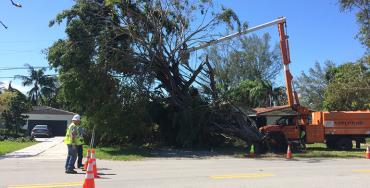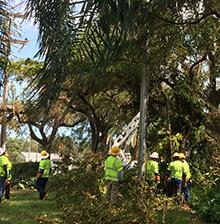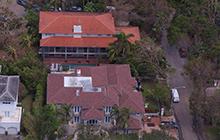
During a special meeting last Thursday, Coral Gables city commissioners and residents took it in turn to lambaste Florida Power and Light Co. for virtually everything Hurricane Irma did to collapse and darken the sweltering Miami-Dade city.
You name it: Failure to remove a transformer from a tree, broken power poles, downed trees left tangled in power lines, crews seen "just standing around" and, of course, the big one -- slow-to-no power restoration.
All FPL's fault.
Said Mayor Raúl Valdés-Fauli of FPL's service, "The level of support for our existing lines has been pathetic."

Added a stern Vice Mayor Patricia Keon to a utility official in attendance, "Go back to the people at FPL and tell them we're tired of being dependent on a monopoly and on a Public Service Commission that does not force FPL to behave ..."
The next day city attorneys fired off a letter to FPL giving the company an ultimatum: Restore the power across the city by Sunday (Sept. 17) or be subject to "a fine of $500 per day consistent with Section 2-203 of the City of Coral Gables Code and fines up to $15,000 consistent with Section 162.09, Florida Statutes."
As you might imagine, this didn't sit well with the nation's third largest electric utility. And not just because Irma affected all 35 counties and the 27,000 square miles the company serves, or that 1,000 restoration workers, including 400 vegetation crewmen, are supporting Coral Gables in the wake of this unprecedented hurricane.
It's because, of all the municipalities in Florida devastated by the big storm, Coral Gables was probably the least entitled to point fingers when the lights and air conditioning went out.
It's because -- and here's the important thing -- not once during the near 90-minute meeting did commissioners tell their residents that FPL had warned them about Coral Gables' practice of planting the wrong trees in the wrong place -- then failing to trim them -- that city vegetation policies and practices invite outage in little more than a stiff wind.
In fairness to the city, commissioners did vow to "have a serious conversation" about underground power lines when the storm is behind them. But, while that will keep the power on, it won't stop badly planted giant trees from blowing over and damaging other property.
Have a look at this video, illustrating the trees that have posed the biggest challenge to restoring power in Coral Gables.
Residents were kept in the dark in more ways than one.

In the first place, FPL has several permits pending with the city for important infrastructure-strengthening improvements, including the installation of technology enhancements that improve outage response time and can even prevent some outages. Why pending? Why haven't these permits been hustled along?
In the second place, the weatherhead can be damaged during a storm by falling trees/branches or wind-blown debris. If this happens, the customer has to hire an electrician to repair it before the utility can reconnect power.
Most important of all, Coral Gables is a tree-canopy city -- very appealing when the sun shines. A truly aesthetic element that should -- should -- contribute to quality of living. But to make tree canopies work with overhead power lines, they have to be the right species of tree -- trees with a strong and deep root system -- planted a proper distance apart, FPL spokesperson Mark Bubriski told me last week. Unfortunately, Coral Gables' trees are massive -- some are more than 90 years old -- many, like the ficus, are nonnative and city staff are well aware of their shallow root structure.
Ficus trees can blow over in a stiff wind, never mind a Category 4 hurricane. And when they do, they block roads, hook out power lines, often crash on a nearby home. FPL needs a special crew to deal with those situations. "Sometimes they're so massive, they're over, but halfway still in the ground and in standing water," said Bubriski.
One FPL arborist said new Coral Gables trees -- date palms, for instance -- come in fully grown and are planted so close together their fronds can't be unwrapped: They're too close to the power lines.
"It can easily take one of our special crews a full day to clear and restore power to a single Coral Gables home," he said.
On Monday evening, FPL -- generally mum when threatened with a legal action -- issued this rare response to Coral Gables' letter:
We understand that it’s extremely frustrating for our customers to be without power. That said, frivolous lawsuits and ludicrous code violations that attempt to pressure us into providing preferential treatment for their City will not work. Our focus is on restoring power to all of our customers, and we will not be moved by self-entitled politicians who are looking for someone to blame for the City’s irresponsibly managed tree program. The fact is the city of Coral Gables has for many years resisted FPL’s well-documented efforts to trim trees and harden our electric system. Unfortunately for our customers in that area, they are now paying the price in terms of extended outages due to hundreds of trees that have fallen into our lines.
While we do not have a precise assessment of the number of City-owned trees that may have been improperly located, resulting in unnecessarily extensive damage to electrical equipment and extended outages for Coral Gables residents, there’s no doubt that the City’s extreme approach to trees is the cause of the problem. More importantly, it threatens the safety of the residents of Coral Gables and the lives of the lineworkers who are trying to restore power.
We have restored 97 percent of Miami-Dade, and thousands of crews are working to restore the remaining customers without power. After restoration is complete, FPL would be happy to work with the City constructively and provide them recommendations on how to avoid some of these problems from reoccurring during severe weather in the future. However, it is important to note, that numerous attempts we’ve made in the past to address the impact of the City’s dense, overgrown vegetation and tree canopy has on the reliability of their residents’ electric service has been ignored.

It seems to me Coral Gables rolled the dice with the health, safety and welfare of their residents. Commissioners had to know what can happen after a big storm, they went through Andrew 25 years ago. One North Gables resident didn't connect the dots, but he made the most salient point to come out of Thursday's special meeting: "It's always the same ... we were three weeks without power in Andrew and two weeks without it in Wilma. ..."
City officials need to take responsibility for their blind eye: Residents are living with the consequences of choices they made. It's that simple.
Said Bubriski, "The trouble is, there's no law against dismissing a utility's advice and planting the wrong trees in the wrong place."
But maybe there should be.
Reach Nancy Smith at nsmith@sunshinestatenews.com or at 228-282-2423. Twitter: @NancyLBSmith
READ MORE FROM SUNSHINE STATE NEWS


